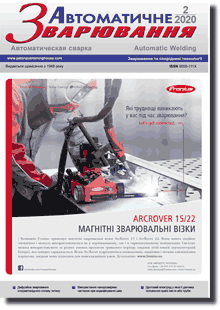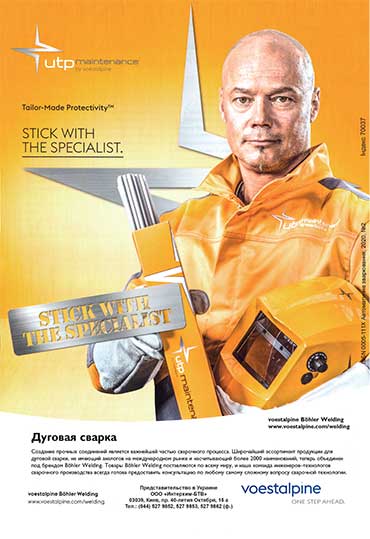| 2020 №02 (08) |
DOI of Article 10.37434/as2020.02.09 |
2020 №02 (10) |

"Avtomatychne Zvaryuvannya" (Automatic Welding), #2, 2020, pp.50-56
Influence of scandium on mechanical properties of welded joints of D16 alloy produced using filler wires of different alloying systems
A.G. Poklyatskii1, V.E. Fedorchuk1, S.I. Motrunich1, Yu.V. Falchenko1, G.P. Kisla2
1 E.O. Paton Electric Welding Institute of the NAS of Ukraine. 11 Kazymyr Malevych Str., 03150, Kyiv, Ukraine. E-mail: office@paton.kiev.ua
2 NTTU «Igor Sikorskii KPI». 37 Peremohi Prosp., 03056, Kyiv, Ukraine.
The impact of scandium in filler wires of SvAMg6, Sv1201 and SvAK5 type, as well as arc oscillations, caused by electric current passage through the filler section, on weld structure formation was studied in nonconsumable electrode argon-arc welding of sheet aluminium alloy D16. Curves of metal hardness distribution in the welding zone are shown and strength limits of welded joints and weld metal after natural ageing of the samples are determined. It is shown that use of scandium filler wires, similar to standard batch-produced ones, leads to formation of a fine-grained dendritic structure of weld metal. However, the subdendritic structure does not form even in welding with arc oscillations, because of a low (0.15 – 0.17%) scandium content in welds. Use of scandium-containing filler wires can lower the degree of weld metal softening at lowering of the total content of the main alloying elements in them. Positive impact of scandium additives together with application of arc oscillations on the degree of softening and ultimate strength of weld metal is noticeable at application of filler wire of Al-Si alloying system. However, the maximum level of strength, both of the welded joints and the weld metal, is ensured in nonconsumable electrode argon-arc welding of D16 alloy 2 mm thick using batch-produced filler wires SvAMg6 and SvMg63. 21 Ref., 2 Tabl., 3 Fig.
Keywords: D16 aluminium alloy, nonconsumable electrode argon-arc welding with arc oscillations, scandium, microstructure, hardness, ultimate strength
Received: 23.12.2019
References
1. Ishchenko, A.Ya., Labur, T.M., Bernadsky, V.N., Makovatskaya, O.K. (2006) Aluminium and its alloys in modern welded structures. Kiev, Ekotekhnologiya [in Russian].2. Beletsky, V.M., Krivov, G.A. (2005) Aluminium alloys (composition, properties, technology, application): Refer. book. Ed. by I.N. Fridlyander. Kiev, KOMINTEX [in Russian].
3. Kablov, E.N. (2000) Main directions of development of materials for aerospace engineering of 21st century. Perspektivnye Materialy, 3, 27-36 [in Russian].
4. Ostash, O.P. (2015) Fracture mechanics and strength of materials: Refer. book. Vol. 15. Structure of materials and fatigue life of structure components. Ed. by V.V. Panasyuk, Lviv, SPOLOM [in Ukrainian].
5. Ishchenko, A.Ya., Labur, T.M. (2013) Welding of modern structures from aluminium alloys. Kiev, NPP NANU [in Russian].
6. Mashin, V.S., Poklyatsky, A.G., Fedorchuk, V.E. (2005) Mechanical properties of aluminium alloys in consumable and nonconsumable electrode arc welding. The Paton Welding J., 9, 39-45.
7. Davydov, V.G., Elagin, V.I., Zakharov, V.V., Rostova, T.D. (1996) On alloying of aluminium alloys with scandium and zirconium additives. Metallovedenie i Termich. Obrab. Metallov, 8, 25-30 [in Russian]. https://doi.org/10.1007/BF01395323
8. Bondarev, B.I., Elagin, V.I. (1992) New aluminium alloys with scandium. Tekhnologiya Lyogkikh Splavov, 5, 22-28 [in Russian].
9. Ishchenko, A.Ya. (2003) Aluminium high-strength alloys for welded structures. In: 2 Vol.: Advanced materials and technologies, Kyiv, Akademperiodika, Vol. 1, pp. 50-82 [in Russian].
10. Milman, Yu.V. (2003) Effect of scandium on structure, mechanical properties and corrosion resistance of aluminium alloys. Ibid., pp. 335-360 [in Russian].
11. Ryazantsev, V.I., Filatov, Yu.A. (2003) Technological aspects of arc welding of aluminium alloys with scandium. Aviats. Promyshlennost, 1, 13-17 [in Russian]. https://doi.org/10.1533/wint.2003.3212
12. Turkina, N.I., Semenova, B.V. (1992) Structure and properties of Al-Mg-Li system alloys with scandium. Tekhnologiya Lyogkikh Splavov, 1, 57-59 [in Russian].
13. Bratukhin, A.G., Tretyak, N.G., Sklabinskaya, I.E. (1993) Structure and mechanical properties of welded joints of aluminium-lithium alloys in welding with scandium-containing test additives. Ibid., 12, 11-15 [in Russian].
14. Zakharov, V.V., Rostova, T.D. (1995) Alloying with scandium of aluminium copper-containing alloys. Metallovedenie i Termich. Obrab. Metallov, 2, 23-27 [in Russian].
15. Elagin, V.I., Zakharov, V.V., Rostova, T.D., Filatov, Yu.A. (1989) Some physical metallurgy principles of alloying, production technology and heat treatment of aluminium scandium-containing alloys. Tekhnologiya Lyogkikh Splavov, 9, 27-34 [in Russian].
16. Fridlyander, I.N., Senatorova, O.G., Novikov, I.I. et al. (1993) Superplasticity of high-strength alloys of Al-Zn-Mg-Cu system alloyed with scandium. Ibid., 7-8, 43-47 [in Russian].
17. Brodyagina, I.V. (1998) Arc welding of aluminium alloys using magnetic fields. Svarochn. Proizvodstvo, 9, 48-51 [in Russian].
18. Poklyatsky, A.G., Ishchenko, A.Ya., Grinyuk, A.A. et al. (2002) Consumable-electrode argon-arc welding of aluminium alloys with arc oscillations. The Paton Welding J., 2, 18-22 [in Russian].
19. Ishchenko, A.Ya., Poklyatsky, A.G., Lozovskaya, A.V. et al. (1990) Influence of low-frequency modulation parameters of rectangular-shaped heteropolar current on weld structure in welding of aluminium alloys. Avtomatich. Svarka, 9, 23-27 [in Russian].
20. Fedorchuk, V.E., Kushnaryova, O.S., Alekseenko, T.A., Falchenko, Yu.V. (2014) Peculiarities of alloying of weld metal of high-strength aluminium alloy welded joints with scandium. The Paton Welding J., 5, 28-32. https://doi.org/10.15407/tpwj2014.05.05
21. Poklyatsky, A.G., Motrunich, S.I. (2019) Strength of welded joints of heat-hardenable aluminium alloys in TIG and friction stir welding. Ibid., 2, 13-18. https://doi.org/10.15407/tpwj2019.02.02
Advertising in this issue:
The cost of subscription/purchase order journals or individual articles
| Journal/Currency | Annual Set | 1 issue printed |
1 issue |
one article |
| TPWJ/USD | 384 $ | 32 $ | 26 $ | 13 $ |
| TPWJ/EUR | 348 € | 29 € | 24 € | 12 € |
| TPWJ/UAH | 7200 UAH | 600 UAH | 600 UAH | 280 UAH |
| AS/UAH | 1800 UAH | 300 UAH | 300 UAH | 150 UAH |
| AS/USD | 192 $ | 32 $ | 26 $ | 13 $ |
| AS/EUR | 180 € | 30 € | 25 € | 12 € |
| SEM/UAH | 1200 UAH | 300 UAH | 300 UAH | 150 UAH |
| SEM/USD | 128 $ | 32 $ | 26 $ | 13 $ |
| SEM/EUR | 120 € | 30 € | 25 € | 12 € |
| TDNK/UAH | 1200 UAH | 300 UAH | 300 UAH | 150 UAH |
| TDNK/USD | 128 $ | 32 $ | 26 $ | 13 $ |
| TDNK/EUR | 120 € | 30 € | 25 € | 15 € |
AS = «Automatic Welding» - 6 issues per year;
TPWJ = «PATON WELDING JOURNAL» - 12 issues per year;
SEM = «Electrometallurgy Today» - 4 issues per year;
TDNK = «Technical Diagnostics and Non-Destructive Testing» - 4 issues per year.









